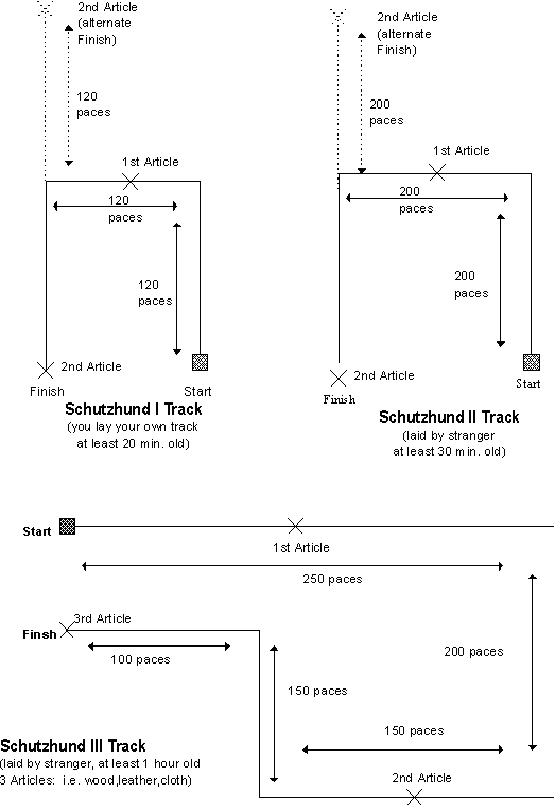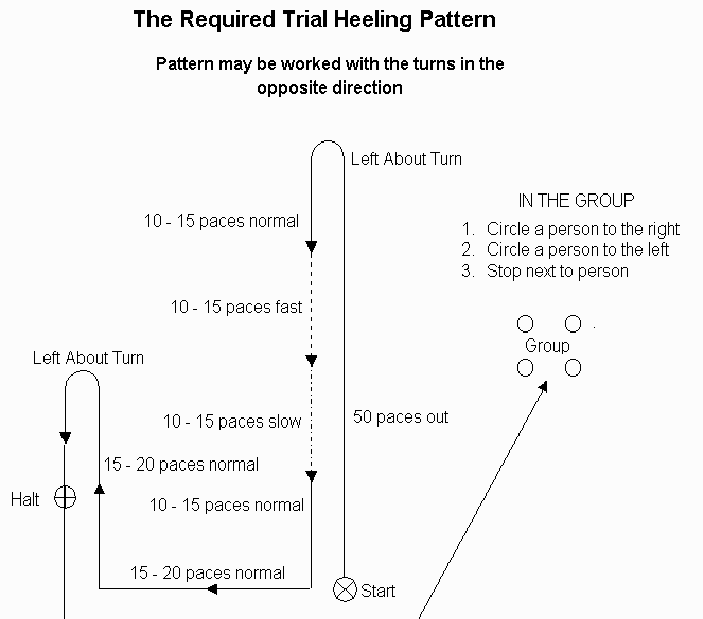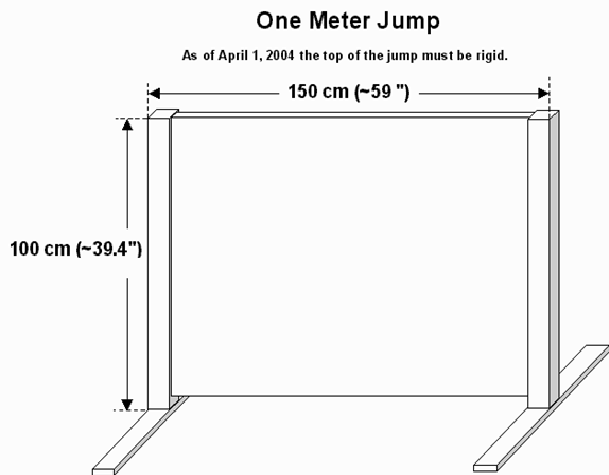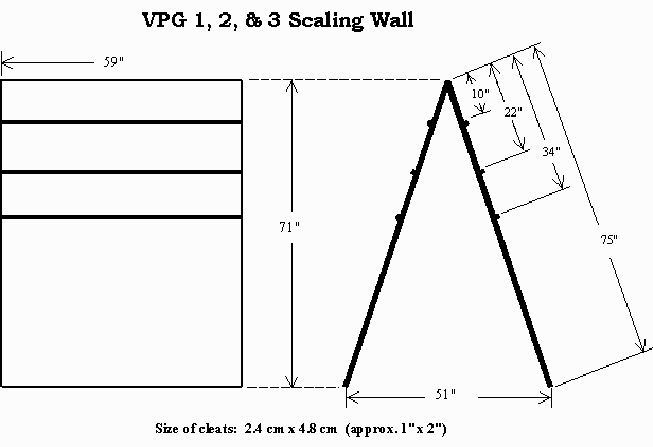WESTERN REGION SCHUTZHUND VERBAND, DVG, INC .
Member LV/DVG America - DVG - DHV - VDH - FCI

BH | VPG I | VPG II | VPG III | FH I | FH II | AD | RH | Helper Regulations
New title available: Stoberprufung - Random Article search
General Information of VPG Trial Rules
&
Sketches of Tracking 1, 2, 3, Obedience Pattern, & Jumps
General abbreviations:
AKZ = Training Degree
AZG = Working Dog Council/Committee of the VDH
AZG-MV = AZG Member Organizations/Associations
FL = Tracklayer
HF = Dog Handler
HL = Helper
HZ = Verbal Command
LR = Trial Judge
PL = Trial Chairperson
PO = Trial Rules
TSB = Triebveranlagung = Drive Assessment
Selbstsicherheit = Self Confidence, Soundness
Belastbarkeit = Ability to withstand stress; toughness; resilience
VDH = German Kennel Club
VPG = Vielseitigkeitsprüfung für Gebrauchshunde = Versatility Test for Working (Utility) Dogs
Note:
On the whole, for simplification reasons, the male version of the abbreviation is used in the following, but is applicable to both men and women.
General Information Part 2:
Validity
These guidelines were formulated by the Working Dog Committee of the VDH and were approved and voted on by the VDH Board on August 16, 2003. These guidelines will become effective on January 1, 2004 and replace all previous regulations.
These trial rules are valid for all member organizations/associations of the VDH. All trial events (trials and tournaments) held within the operating purview of the VDH must comply with these rules.
Upon these rules taking effect, all previous rules cease to be valid.
General Information:
Trials and tournaments should serve two purposes. The first purpose is to determine a dog's suitability for a particular use by obtaining a title. The other purpose is to help to maintain or increase the health and working ability, as far as working dog characteristics are concerned, from generation to generation within the breeding program. They also help to maintain and increase health and fitness. A working title is also considered proof of a dog's suitability for breeding.
All trials and tournaments are subject to the principles of sportsmanship regarding the hosting of events and regarding the conduct of the participants. The regulations stated in these guidelines are binding for all parties involved. All participants must comply with the same performance requirements. The events are open to the public. The membership must be publicly informed of the location of the event and the time the event starts.
Trials and tournaments must fulfill all trial levels or separate complete parts of a particular trial level. A valid training title is earned by successfully completing the attempted trial level. The training degrees are to be recognized by all AZG member organizations.
For events not of the nature of a trial, the regulations of each respective trial rules are valid.
Protection only events are not permitted.
Trial Season
Trials can be held throughout the entire year if weather permits and the health and safety of people and animals are not put at risk. Otherwise, the event cannot be held. The trial judge makes this decision.
Trial Organization/Trial Chairperson (PL)
The trial chairperson is responsible for organizing the event. The trial chairperson handles or supervises all tasks necessary to prepare for and conduct a trial. The PL insures that the trial is run in an orderly fashion and must be at the judge's disposal throughout the entire event.
The PL is not allowed to show a dog or take on other duties. The Trial Chairperson is responsible for:
- Obtaining all necessary event authorizations.
- Providing suitable (in accordance with trial regulations) tracking fields for all trial levels.
- Making arrangements with the owners of the tracking fields and persons who may have acquired hunting rights for this property.
- Getting experienced volunteers, for example helpers for the protection phase, tracklayers, people for the group, etc.
- Securing the trial date.
- Providing all necessary trial equipment (in accordance with PO-Regulations) and proper protective clothing for the helpers.
- Providing forms, such as judge's books and score sheets for all trial levels.
- Making available scorebooks, registration papers, proof of vaccination and if necessary, proof of liability insurance.
The chairperson must inform the judge three days prior to the event of the location of the trial, the time the trial starts, directions to the trial site, type of examinations and number of dogs. If the PL fails to provide the judge with this information, the judge has the right to withdraw from his/her commitment.
The event authorization form must be presented to the judge prior to the start of the trial.
Trial Judges
The officers of the hosting club are responsible for inviting a judge who is authorized to conduct VPG trials, or is appointed according to the regulations of the AZG member organization. The host club determines how many judges are requested. However, one judge may judge a maximum of 30 individual parts per day.
BH/VT with written test Equals 3 parts
BH/VT without written test Equals 2 parts
VPG 1, 2 and/or 3 Equals 3 parts each
FH 1, FH 2 Equals 3 parts per track
Tracking Degree 1-3 Equals 1 part each level
StP 1-3 (Random Article Search) Equals 1 part each level
WH and RTP (Rescue Dog Suitability Test) Equals 2 parts each
For major events scheduled by AZG member organizations, each can establish special regulations.
The judge is not permitted to evaluate dogs that are owned by him or that he has in his possession. The judge is not permitted to evaluate dogs that are owned or in the possession of a person living in the same household with him. The judge is not permitted to evaluate dogs that are shown by a person living in the same household. If the judge is appointed to an event by the AZG member organization or the Working Dog Committee, this rule does not apply. [This simply means that in championships, a judge may judge someone living in the same household, should that person qualify for the championship.]
The judge is not permitted to influence or distract a dog's performance through his behavior. The judge is responsible for observing and the correctly applying the valid trial rules. The judge is entitled to terminate a trial if it is not conducted in accordance with the trial regulations and instructions are ignored. In this case the judge must submit a report to the appropriate organization.
The judge is authorized to dismiss a dog from the trial that is injured or that exhibits diminished ability to perform, even against the judgement of the handler. If the handler pulls the dog, the entry made in the scorebook is to be "Unsatisfactory as a result of quitting." If the handler pulls the dog because of an obvious injury or presents a veterinarian's certification to that effect, the entry into the scorebook is "Terminated because of Illness" or "Terminated because of Injury". The judge is authorized to disqualify a handler for unsportsmanlike conduct, carrying any type of motivational article [i.e., food, toy, etc., during a trial performance], violations against the trial rules, against the animal protection laws and against good manners. In any case, premature termination of the trial is to be substantiated by a note in the scorebook. If the handler is disqualified, no points earned are entered in the scorebook.
A judge's decision is final and incontestable. Any form of criticism regarding the evaluation can lead to dismissal from the trial field and may eventually result in disciplinary action. In legitimate cases, regarding a violation of the trial rules by the judge and not a judge's decision, a complaint can be filed within eight days. The complaint is to be submitted in writing, signed by the complainant and at least one additional witness via the host club Trial Chairperson. No right of revision of the judge's decision is derived from the acceptance of a complaint. The appropriate Board of the AZG member organization/association is responsible for making a decision regarding the complaint.
Trial Participants
The participant must meet the entry deadline for the trial. Once the entry form has been submitted, the participant is obligated to pay the entry fee. In the event that the participant cannot participate in the trial for whatever reason he/she must immediately contact the trial chairperson. The trial participant must comply with any local veterinary and animal protection regulations
At the beginning of the trial, each participant in turn, with the dog either on lead or off lead in the basic position, reports to the judge in a sportsmanlike manner, stating his/her name and the name of the dog. The participant must follow the instructions of the judge as well as those of the trial chairperson. The handler must show the dog in a sporting and impeccable manner. A handler must show his dog in all parts of the trial, regardless of the outcome in any one part. The trial ends with the announcement of the final scores (award ceremony) and return of the scorebooks.
The handler must carry a leash throughout the entire trial. The dog must wear a simple, single-row, loose-fitting chain collar on the dead ring at all times. Any additional collars (such as leather or tick-collars, etc.) are not permitted during the trial. The leash can be carried so it is invisible for the dog, or the handler can put the leash over his/her shoulder from top left to bottom right.
Only in the BH/VT test is a harness permitted, to which no additional straps are to be attached.
Verbal commands are to be brief, given in a normal voice, consisting of one single word. The commands can be given in any language, but the same command must be used for the same function at all times. (Valid for all divisions.)
A handler may participate with no more than two dogs in a single trial and can participate in only a single trial per day.
Physically Disabled Handlers
A handler who is physically disabled and as a result cannot heel the dog on the left side may heel the dog on the right side. The same rules for a dog heeling on the right side as on the left.
Muzzle Restrictions
The federal or national enacted as well as individual state enacted laws regarding dogs in public places are to be observed. Handlers and dogs that are bound by applicable laws may perform with a muzzle, for example in the traffic portion of the BH test.
Trial Requirements
On the day of the trial the dog must have reached the required age. No exceptions are allowed.
A prerequisite to participate in a trial, in accordance with the national VDH trial rules, is proof of a successfully passed VDH BH test. (BH-VT)
BH/VT 15 Months
FPr 1-3 (Tracking Test) 15 Months
StP 1-3 (Random Article Search) 15 Months
VPG A 18 Months
VPG 1 18 Months
VPG 2 19 Months
VPG 3 20 Months
FH 1 18 Months
FH 2 20 Months
RTP (Rescue Dog Suitability Test) 15 Months
WH 15 Months
All dogs, regardless of their size, breed or proof of pedigree are allowed to participate. The dog must be able to meet the requirements of the VPG title.
A minimum number of 4 participants is required to hold a trial. A single participant trial is not allowed.
If an AD is scheduled with a trial, it is left up to the judge whether or not he/she wishes to conduct the AD. The judge is under no requirement to do so.
Dogs, which were entered in the trial, may also enter the AD. The AD participants do not have to be added to the number of trial entries.
Each degree can be repeated as many times as desired. The trial levels are to be completed in sequence (levels 1-2-3). A dog may only be shown at the next higher level upon passing the previous level. In order to go on to the next higher degree, the dog must earn a minimum of 80 points in Part C. The age requirement must be considered. A dog must always be shown in the highest degree it has earned. An exception can be made in trials that are not connected with a qualification or ranking (repeater). Dogs over 6 years old can be shown in the Aged Class (Alterklasse) after making application to the appropriate AZG member organization. After receiving reclassification to the Alterklasse, dogs may only participate at trial levels VPG 1, IPO 1 and FH 1.
Bitches in season may participate in all events. However, they must be kept apart from the rest of the participants. They will be shown according to [draw] schedule in part A of the trial. [Explanation: Bitches in heat are not required to go last in tracking. They will track according to draw number.] In all other phases they will be placed at the end of the starting order. They will be shown at the end of the trial. Pregnant and nursing females are excluded from the trial.
Sick and contagious animals are excluded from all events.
Temperament Test
Before any trial starts, prior to the first examination phase, the dogs must undergo an impartiality test (temperament test). Part of the temperament test is the identity inspection (examination and verification of the tattoo-number, chip, etc.). Dogs that do not pass the temperament test cannot participate in the trial and must be disqualified. Owners of dogs that are micro chipped are responsible for providing the necessary equipment for the identity check.
The judge will continue to evaluate the temperament throughout the entire trial. The judge is obligated to immediately disqualify a dog if that dog shows a defective temperament. A notation must be made in the scorebook, explaining the temperament fault. Dogs that were disqualified because of a temperament defect must be reported in writing to the appropriate office of the AZG member organization.
Conduct of the Temperament Test
1. The temperament test must be performed under normal environmental conditions in a neutral location for the dog.
2. Each dog will be presented to the judge separately.
3. The dog is presented to the judge on a regular leash. The leash must hang loosely.
4. The judge must avoid any type of provocation. The judge is not allowed to touch the dog.
Evaluation:
a.) Positive response of the dog: The dog shows itself, for example, to be neutral, self-confident, secure, attentive, full of spirit, impartial
b.) Still acceptable borderline cases: For example, the dog is somewhat unstable, slightly nervous, and slightly insecure. Such dogs can still pass the temperament test, but must be kept under close observation throughout the entire trial.
c.) Negative response of the dog or defective temperament: For example, the dog is shy, insecure, nervous, gunshy, out of control, bites, is aggressive (disqualification).
Scoring System:
A performance is evaluated in points and ratings (qualification). The ratings (qualification) and corresponding points must reflect the quality of the performance.
Point table:
|
Maximum Points |
Excellent (Vorzüglich) |
Very Good (Sehr Gut) |
Good (Gut) |
Satisfactory (Befriedigend) |
Insufficient (Mangelhaft) |
|
5 points |
5 |
4.5 |
4.0 |
3.5 |
3.0-0 |
|
10 points |
10 |
9.5-9.0 |
8.5-8.0 |
7.5-7.0 |
6.5-0 |
|
15 points |
15.0 - 14.5 |
14.0 - 13.5 |
13.0 - 12.0 |
11.5 - 10.5 |
10.0 - 0 |
|
20 points |
20.0 - 19.5 |
19.0 - 18.0 |
17.5 - 16.0 |
15.5 - 14.0 |
13.5 - 0 |
|
30 points |
30.0 - 29.0 |
28.5 - 27.0 |
26.5 - 24.0 |
23.5 - 21.0 |
20.5 - 0 |
|
35 points |
35.0 - 33.0 |
32.5 - 31.5 |
30.5 - 28.0 |
27.5 - 24.5 |
24.0 - 0 |
|
70 points |
70.0 - 66.5 |
66.0 - 63.0 |
62.5 - 56.0 |
55.5 - 49.0 |
48.5 - 0 |
|
80 points |
80.0 - 76.0 |
75.5 - 72.0 |
71.5 - 64.0 |
63.5 - 56.0 |
55.5 - 0 |
|
100 points |
100.0 - 96.0 |
95.5 - 90.0 |
89.5 - 80.0 |
79.5 - 70.0 |
69.5 - 0 |
Percentages:
|
Rating |
Awarded percentage |
Deduction |
|
Excellent |
= minimum 96% |
or up to minus 4% |
|
Very good |
= 95 to 90% |
or minus 5 to 10% |
|
Good |
= 89 to 80% |
or minus 11 to 20% |
|
Satisfactory |
= 79 to 70% |
or minus 21 to 30% |
|
Insufficient |
= below 70% |
or minus 31 to 100% |
Only whole points shall be given in the overall rating of each complete phase. Partial points may be given for individual exercises. At the end of trial phase, if the points do not total a whole number, the total can be rounded up or down, depending on the overall impression.
In case of a tie, the winner is determined by the higher score in Part C. Should there still be a tie, the higher total points in Part B determines the winner. Scoring results that coincide in all three phases shall be considered as placing the same.
Disqualification
A handler/dog team is disqualified from further participation in a trial if a judge decides the dog has a faulty temperament; unsportsmanlike conduct on the part of the handler (for example, alcohol use, carrying a motivational article and/or food), violations of the trial rules, violations of the animal protection laws or actions contrary to accepted standards of behavior.
With this disqualification, all points awarded previously (including points earned in other phases) are disallowed. Neither rating (Qualification) nor points are to be entered in the trial paperwork.
If the dog does not remain in the control of the handler (for example, in the side or back transports; the dog leaves the handler or field during the trial and does not return after being called 3 times; the dog will not out; the dog bites the helper someplace other than the bite sleeve), the dog/handler team is disqualified from further participation in the trial.
With this disqualification, the points awarded previously in this particular part of the trial are disallowed. Neither rating (Qualification) nor points are to be entered for this trial part in the trial paperwork.
Evaluation
A degree can only be awarded if a dog achieves at least 70% of the total points in each phase of a trial.
|
Maximum Points |
Excellent (V) |
Very Good (SG) |
Good (G) |
Satisfactory (B) |
Unsatisfactory (M) |
|
100 points |
100 - 96 |
95 - 90 |
89 - 80 |
79 - 70 |
69 - 0 |
|
300 points |
300 - 286 |
285 - 270 |
269 -240 |
239 - 210 |
209 - 0 |
|
200 points (VPG A) |
200 - 192 |
191 - 180 |
179 - 160 |
159 - 140 |
139 - 0 |
Scorebooks
Each participating dog must have a scorebook. The scorebook is issued according to the regulations of the handler's appropriate organization. Only one scorebook may be issued by the AZG member organization per dog. The organization/association issuing the scorebook assumes this responsibility. In any case, the judge enters the trial results in the scorebook, and, if there is a provision made in the scorebook, the trial chairperson must check the entry and verify it with his/her signature.
Liability
The owner of a dog is liable for any personal injury or material damage caused by the dog. Therefore, the owner must have adequate insurance. In case of an accident, the handler is liable for himself/herself and the dog throughout the event. The handler follows the instructions given by the judge and the organizer of his/her own free will and executes the instructions on his/her own risk.
Vaccinations:
Prior to the beginning of the trial, at the request of the judge or the trial secretary, the handler must provide proof of proper vaccinations (vaccination certificate).
Trial Supervision
The AZG member organization is entitled to supervise the conducting of the trial. The AZG member organization can assign a knowledgeable person to oversee an event to make certain it is conducted in accordance with the regulations stated in the guidelines.
"TSB" Rating
The "TSB"-Evaluation should serve the purpose of describing a dog's character traits in regards to breeding suitability. The "TSB" Rating neither influences the trial result nor influences the trial ranking. A dog must complete at least one protection exercise to receive a "TSB" Rating.
The ratings of pronounced (a), present (vh), and insufficient (ng) describe the following characteristics:
Triebveranlagung; Selbstsicherheit; and Belastbarkeit.
TSB "pronounced" (ausgeprägt)
Is given to a dog that shows strong willingness to work, clear instinctive behavior, determination in its performance; appears self-confident, pays undivided attention and is capable of coping with a severe amount of stress.
TSB "present" (vorhanden)
Is given to a dog that has limitations concerning its willingness to work, instinctive behavior, self-confidence, attentiveness and ability to cope with stress.
TSB "insufficient" (nicht genügend)
Is given to a dog with insufficient willingness to work, insufficient instinctive behavior, lacking self-confidence and that has insufficient ability to cope with stress.
Rules of Discipline
The event organizer or chairman is responsible for guaranteeing order and safety within the entire trial or event grounds.
The judge is authorized, in the case of failure to observe the rules or for safety reasons, to suspend or terminate the trial.
Gross violations by the handler against these regulations, against the trial rules, against the animal protection laws and against the rules of common decency can lead to expulsion from the trial.
In this case, the judge must deliver a report to the appropriate association/organization. Following this, a statement will be requested from the parties concerned, which can then lead to a decision about the disciplinary action.
Expulsion must be determined in the disciplinary committees of the association/organizations A report is to be made in every case to the AZG Headquarters.
The expulsion of a person from a club or an organization can be published in the respective association's/organization's magazine.
The decision of the judge is incontestable. Any criticism of the decision of the decision can bring about expulsion from the trial field and eventual disciplinary action. In legitimate cases, which don't relate to the factual decisions, but rather violations of the rules by the judge, it is possible to file a complaint. This complaint is to be submitted in writing to the appropriate association/organization. It can only be submitted by the trial/event chairman and must be signed by the complainant, the president of the club and one of the additional witnesses. This complaint must be received within 8 days following the incident. No right of revision of the judge's decision is derived by the acceptance of such a complaint. Videotapes are not valid as proof.
Special Regulations
The AZG member organization is entitled to expand (modify) general regulations within their domain. For example, rules concerning permits, veterinary requirements, animal protection laws or sanitary regulations can be adjusted to differences in legislation within the state. Handlers may give verbal commands in their own language.
Sketches of Tracking, Obedience Pattern, & Jumps

Sketches of Tracking, Obedience Pattern, & Jumps




